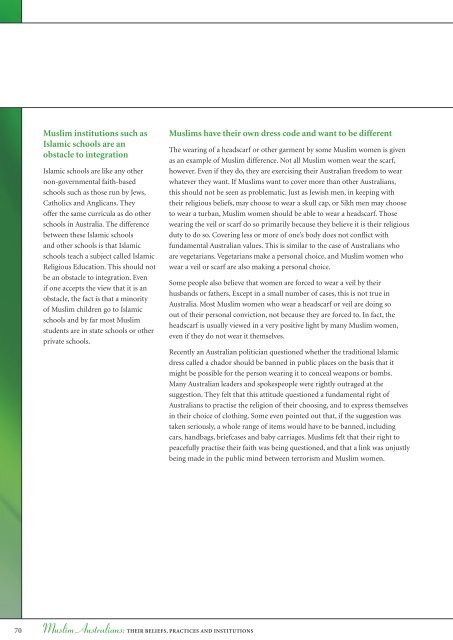Muslim Australians - Religion Cultural Diversity Resource Manual
http://www.islamicglobe.com
http://www.islamicglobe.com
You also want an ePaper? Increase the reach of your titles
YUMPU automatically turns print PDFs into web optimized ePapers that Google loves.
<strong>Muslim</strong> institutions such as<br />
Islamic schools are an<br />
obstacle to integration<br />
Islamic schools are like any other<br />
non-governmental faith-based<br />
schools such as those run by Jews,<br />
Catholics and Anglicans. They<br />
offer the same curricula as do other<br />
schools in Australia. The difference<br />
between these Islamic schools<br />
and other schools is that Islamic<br />
schools teach a subject called Islamic<br />
Religious Education. This should not<br />
be an obstacle to integration. Even<br />
if one accepts the view that it is an<br />
obstacle, the fact is that a minority<br />
of <strong>Muslim</strong> children go to Islamic<br />
schools and by far most <strong>Muslim</strong><br />
students are in state schools or other<br />
private schools.<br />
<strong>Muslim</strong>s have their own dress code and want to be different<br />
The wearing of a headscarf or other garment by some <strong>Muslim</strong> women is given<br />
as an example of <strong>Muslim</strong> difference. Not all <strong>Muslim</strong> women wear the scarf,<br />
however. Even if they do, they are exercising their Australian freedom to wear<br />
whatever they want. If <strong>Muslim</strong>s want to cover more than other <strong>Australians</strong>,<br />
this should not be seen as problematic. Just as Jewish men, in keeping with<br />
their religious beliefs, may choose to wear a skull cap, or Sikh men may choose<br />
to wear a turban, <strong>Muslim</strong> women should be able to wear a headscarf. Those<br />
wearing the veil or scarf do so primarily because they believe it is their religious<br />
duty to do so. Covering less or more of one’s body does not conflict with<br />
fundamental Australian values. This is similar to the case of <strong>Australians</strong> who<br />
are vegetarians. Vegetarians make a personal choice, and <strong>Muslim</strong> women who<br />
wear a veil or scarf are also making a personal choice.<br />
Some people also believe that women are forced to wear a veil by their<br />
husbands or fathers. Except in a small number of cases, this is not true in<br />
Australia. Most <strong>Muslim</strong> women who wear a headscarf or veil are doing so<br />
out of their personal conviction, not because they are forced to. In fact, the<br />
headscarf is usually viewed in a very positive light by many <strong>Muslim</strong> women,<br />
even if they do not wear it themselves.<br />
Recently an Australian politician questioned whether the traditional Islamic<br />
dress called a chador should be banned in public places on the basis that it<br />
might be possible for the person wearing it to conceal weapons or bombs.<br />
Many Australian leaders and spokespeople were rightly outraged at the<br />
suggestion. They felt that this attitude questioned a fundamental right of<br />
<strong>Australians</strong> to practise the religion of their choosing, and to express themselves<br />
in their choice of clothing. Some even pointed out that, if the suggestion was<br />
taken seriously, a whole range of items would have to be banned, including<br />
cars, handbags, briefcases and baby carriages. <strong>Muslim</strong>s felt that their right to<br />
peacefully practise their faith was being questioned, and that a link was unjustly<br />
being made in the public mind between terrorism and <strong>Muslim</strong> women.<br />
70 <strong>Muslim</strong> <strong>Australians</strong>:THEIR BELIEFS, PRACTICES AND INSTITUTIONS














